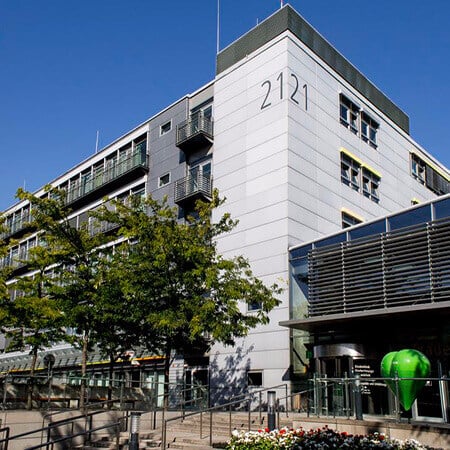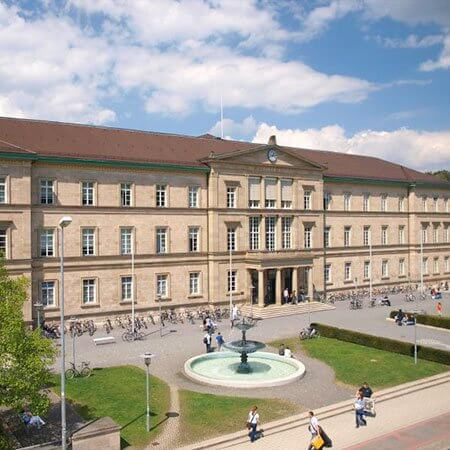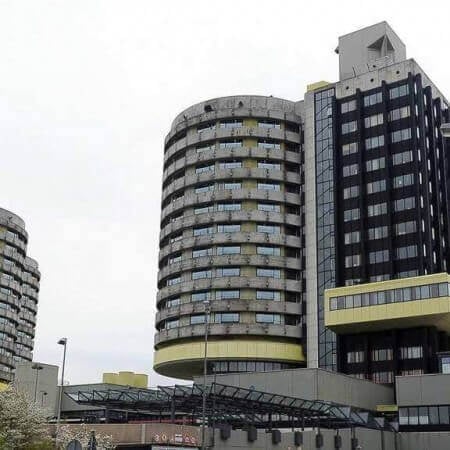Knee instability is an impairment of the ability of the knee joint to maintain the correct axis of the lower limb. When walking, the knee can be deflected forward, backward, inward or outward, or abnormal rotation of the lower leg occurs. Joint movements are limited due to the ligaments. Most cases of instability are associated with their rupture. Pathology can also develop due to bone structure lesions. Doctors abroad successfully treat knee instability with minimally invasive surgery. Full rehabilitation allows patients to return to their maximum level of physical activity 4-6 months after a surgical intervention.
Content
- Causes of knee instability
- Diagnostics
- Conservative therapy
- Anterior cruciate ligament plastic surgery
- Damage to several ligaments
- Rehabilitation
- Why is it worth undergoing treatment of knee instability abroad
- Treatment in Europe at an affordable price
Causes of knee instability
Knee instability is usually the result of the previous knee ligament injuries. This is the most commonly injured joint. Knee injuries account for 50% of all registered joint injuries.
The most common injury is meniscus tear. In second place is the cruciate ligament rupture. It is not uncommon for these two injuries to be detected at the same time. At risk are young people and adolescents who play sports and lead an active lifestyle.
Developed countries are making significant advances in the treatment of knee instability. Previously, after joint injuries, patients often received conservative treatment, which did not always lead to good functional outcomes. But in recent years, surgical procedures have become less traumatic thanks to the introduction of arthroscopy. Therefore, the frequency of their use is increasing. In the last 15 years alone, the number of operations for knee injuries in developed countries has quadrupled.
Athletes are most often injured. Each day, anterior cruciate ligament ruptures occur in 1 out of 1,500 skiers and 1 out of 1,700 football players. This is one of the most common injuries in sports. It accounts for 2.6% of all injuries of the musculoskeletal system.
Among patients with knee instability are more men, as they are more likely to play sports. However, among female athletes, knee injuries are more common in percentage terms. Their ligaments are weaker, they break more easily, so the risk of developing knee instability is 4-10 times higher, according to different authors.
Another cause of instability is external patellar dislocation. In 80% of cases, they occur due to congenital structural features of the knee. The most common prerequisites are a flat intercondylar notch, a dysplastic type of structure and a high position of the patella, displacement of the tibial tuberosity, or a generalized joint hypermobility syndrome. There are currently over 160 different surgical procedures to correct this cause of knee instability.
Diagnostics
If instability develops, the doctor must find out the cause of this condition in order to choose the best therapy option. At the examination stage, the following diagnostic procedures can be carried out:
- Functional tests – the doctor determines which movements in the knee are excessive or limited in order to find out which anatomical structures are damaged.
- MRI – the best way to visualize structures within a joint.
- Direct magnetic resonance arthrography – the procedure involves the introduction of a contrast agent into the joint, which makes the diagnosis more accurate.
- Diagnostic arthroscopy is the most accurate, but invasive examination, involving the introduction of a thin tube with a video camera into the patient's knee.
Conservative therapy
Conservative therapy is ineffective in knee instability treatment. If the stability of the joint is impaired, this indicates that the ligaments or bone structures are damaged. Anatomical defects can only be corrected with surgery.
Conservative therapy is of secondary importance. With its help, doctors can eliminate pain, swelling, and relieve joint inflammation. After the surgical intervention, doctors use both medicines and non-drug treatments to speed up the patient's recovery and ease the postoperative period.
Anterior cruciate ligament plastic surgery
Anterior cruciate ligament rupture is the most common cause of knee instability. There are more than 250 methods of surgical treatment of this pathology described in the literature.
The surgery should be performed as early as possible, preferably no later than 3 months after the knee injury. Otherwise, damage to the menisci, degeneration of the articular cartilage, damage to the joint capsule and other ligaments may occur. In recent years, specialists try to perform the surgical intervention in the acute period of trauma.
Although there are a variety of surgical treatment methods, their essence is similar. Doctors suture a torn ligament, suture other tissues to it (hybrid operations) or perform plastic surgery. In fact, they form a new ligament from other ligaments or tendons, donor tissues, and artificial materials.
The most commonly used group of surgical interventions is the anterior cruciate ligament plastic repair. The most widespread is autoplasty. It provides the most reliable results. The restored ligament turns out to be strong, the risk of its repeated rupture is very low, which is especially important for athletes and young physically active people.
The following materials can be used for autoplasty:
- Patient's own patellar ligament.
- Peroneus longus tendon.
- Patellar tendon.
- Hamstring tendon.
- Achilles tendon.
There is no ideal option. Some surgical options provide more reliable results, while others have a lower risk of complications. Each method has its own advantages and disadvantages. Different countries use different types of plastic surgery. For example, in North America, doctors prefer to use the Achilles tendon or the patella's own ligament. Doctors in Europe often use tendons of the semimembranosus, thin, posterior tibial muscle for plastic surgery. Plastic repair of the patient's own patellar ligament can rarely be performed due to the risk of complications from the donor site: long-term pain, patellar tendonitis, and patellofemoral arthrosis.
To reduce the trauma of the operation, alloplasty can be performed. With this approach, doctors use a preserved donor ligament or tendon. The advantages of this approach are obvious: there is no trauma to the donor site, the operation is less traumatic, there are no scars in the incision area (a better cosmetic effect). In addition, the graft can be perfectly sized. Nonetheless, there is a big drawback: the new ligament will not be very strong. Therefore, this type of surgery is not suitable for athletes, but it can be used for elderly people with low physical activity.
Some hospitals use synthetic materials for ligament plastic surgery. Like allografts, they are less durable than the patient's own ligaments and tendons.
To fix the new ligament inside the knee, doctors use titanium screws, bone nails, compression impaction, and anchor clamps.
Damage to several ligaments
With severe knee injuries, several ligaments can sometimes be damaged at once. In addition to the anterior cruciate ligament, it can be the posterior cruciate or lateral ligaments. Such concomitant injuries are rare. They usually result from a direct blow to the knee. As a result of falling from a height or traffic accidents, damage to the ligamentous apparatus can occur.
The damage to several ligaments can be corrected with the help of one or more surgical interventions. Whenever possible, preference is given to a single-stage correction. Doctors more often perform the single-stage plastic surgery of the anterior cruciate and lateral knee ligaments. With the posterior cruciate ligament damage, the two-stage correction is often performed. The interval between operations is 4 to 6 months. Compared to the single-stage intervention, this approach reduces the risk of some complications, primarily contracture (stiffness) and recurrence of knee instability.
Along with the cruciate ligament, the knee meniscus can often be damaged as well. The correction of these two pathologies can be carried out simultaneously or in two stages. The preference is given to the single-stage surgery to eliminate two consequences of the traumatic knee injury. Most doctors perform anterior cruciate ligament plastic surgery, resection or meniscus suture repair using the single-stage approach. Less commonly, the treatment can be performed in two stages. In this case, the intervention is first performed on the meniscus, and after a while the ligamentous apparatus is operated on. The time interval between two surgical interventions should be reduced to a minimum, since until the integrity of the anterior cruciate ligament is restored, the risk of repeated meniscus tear remains increased.
Rehabilitation
After the surgical correction of knee instability, patients require long-term rehabilitation. Ligaments grow together very slowly. Some surgical procedures involve additional bone tissue intervention. Therefore, rehabilitation takes from 4 to 6 months, depending on the type of surgery performed, the patient's health status, the effectiveness of the rehabilitation program and the requirements for the final outcomes.
The main method of rehabilitation is physical training (therapeutic exercises). The volume of loads is selected individually and gradually increases. Medical facilities abroad use advanced types of special rehabilitation exercise devices, which help to quickly restore muscle strength and proprioceptive sensitivity.
Massage and physiotherapeutic procedures, passive movements in the joint, electrical muscle stimulation – all these procedures are important in the first few days after the operation. They help improve blood circulation, eliminate edema, and slow down atrophic changes in the muscles of the limb. In the following months, these methods are used in rehabilitation to recover from physical training.
After ligament surgery, rehabilitation takes place in 4 phases:
- Phase 1 lasts about 1 month. During this period, the mobility of the limb is limited by a bandage. Nevertheless, by the end of the first month, patients should restore the range of motion in the joint, learn to walk without crutches and work on strengthening the thigh muscles. Doctors use a variety of procedures and medications to relieve knee pain, inflammation and swelling.
- Phase 2 lasts up to 2.5 months. The patient can already work out in the gym, swimming pool, and on rehabilitation exercise equipment. The objective of this stage is to bring the range of motion in the knee to the level that was before the injury. Other goals include complete control when walking, balance, increased muscle strength in the limb.
- Phase 3 lasts up to 4 months. Limb strength reaches 90% of a healthy leg. The patient can already run and return to sports training. A person is working out on an exercise bike, treadmill, rowing machine.
- Phase 4 lasts up to 6 months. This phase aims to completely relieve pain, swelling, coordination, and return the patient to the previous sports form. Upon completion of this stage, the person can return to maximum loads.
Why is it worth undergoing treatment of knee instability abroad
In developed countries, modern minimally invasive procedures and surgical interventions are used to restore the stability of the knee joint. You can expect to return to your previous physical activity as soon as possible after treatment. In the long-term postoperative period there will be no pain, swelling, the strength and sensitivity of the limb will be fully restored. You can return to physical labor or sports. The relapses of instability after treatment are extremely rare in developed countries.
There are several reasons for you to undergo treatment abroad:
- Most of the surgical interventions are performed using minimally invasive techniques: through several punctures in the knee area instead of a large incision.
- Reliable methods of plastic repair of torn ligaments.
- Minimal risk of complications.
- Possibility of simultaneous correction of several knee injuries at once: plastic surgery of several ligaments, restoration of the meniscus and knee ligaments.
- Early rehabilitation to reduce the risk of complications and shorten the length of hospital stay.
- Full rehabilitation will allow you to quickly return to the previous level of physical activity or reach the peak of sports form.
Treatment in Europe at an affordable price
To undergo knee instability treatment in one of the European hospitals, please use the services of the Booking Health company. On our website, you can find out the cost of treatment in different hospitals and compare prices in order to book a medical care program at a favorable price. The treatment of knee instability in a European hospital will be easier and faster for you, and the cost of treatment will be lower.
You are welcome to leave your request on the Booking Health website. Our specialist will contact you and provide a free consultation on treatment in Europe. Booking Health will take care of the organization of your trip abroad. We will provide the following benefits for you:
- We will select a hospital for treatment in Europe, whose doctors specialize in the treatment of knee instability and achieve the best results.
- We will solve the problem of the language barrier, and help to establish communication with your doctor.
- We will reduce the waiting time for the medical care program. You will undergo treatment at the most suitable dates for you.
- We will reduce the price. The cost of treatment in European hospitals will be lower due to the lack of overpricing and additional coefficients for foreign patients.
- We will help you solve any organizational issues: we will draw up documents, meet you abroad and take you to the hospital, book a hotel, provide interpreting services.
- We will prepare a program and translate medical documents. You will not need to repeat the previously performed diagnostic procedures.
- We will help you keep in touch with the hospital after the completion of your treatment in Europe.
- We will arrange additional diagnostic examinations and treatment in a European hospital, if required.
- We will buy medicines in another country and forward them to your native country.
The world's leading doctors will take care of your health. The specialists of the Booking Health company will help reduce the cost of treatment, organize your trip, and you can fully focus on restoring your health.
Authors:
This article was edited by medical experts, board-certified doctors Dr. Nadezhda Ivanisova, and Dr. Bohdan Mykhalniuk. For the treatment of the conditions referred to in the article, you must consult a doctor; the information in the article is not intended for self-medication!
Our editorial policy, which details our commitment to accuracy and transparency, is available here. Click this link to review our policies.



















